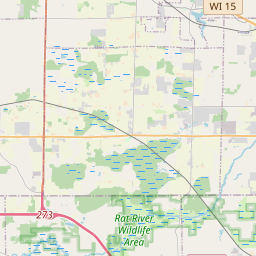First Edison Hydroelectric System in America
Historical marker location:
530 South Vulcan Street, Appleton, Wisconsin
( Marker can be reached from South Lawe Street, on the right when traveling south.)
Marker installed: 1979







© OpenStreetMap contributors
Loading...
Searching for other points of interest within 10 miles of this location.Wisconsin was the first state in the United States to provide workers' compensation for injured workers, in 1911.
About Outagamie County
Outagamie County Timeline
Outagamie County, located in northeastern Wisconsin, has a rich history dating back thousands of years. Before European settlement, the area was inhabited by Native American tribes such as the Menominee, Ojibwe, and Potawatomi. The first explorers in the region were French fur traders, including Jean Nicolet, who arrived in the 17th century. The area became part of the United States in 1783, after the American Revolution.
In the early 19th century, Outagamie County saw an influx of European settlers, primarily of German and Dutch descent. The construction of the Erie Canal in the 1820s and the subsequent opening of the Great Lakes to trade led to increased migration to the area. Agriculture became a key industry, with settlers cultivating crops like wheat, barley, and corn. The first permanent European settlement in what is now Outagamie County was established in 1825 by James Duane Doty, who also served as the first governor of the Wisconsin Territory.
The mid-19th century brought both prosperity and challenges to Outagamie County. It became a major transportation hub with the completion of the railroad in 1854, linking the region to larger cities like Milwaukee and Chicago. The county experienced significant growth, with new industries emerging, such as lumber mills and paper mills. However, this period also witnessed conflicts between settlers and Native American tribes, leading to the Fox Wars in 1856 and the Treaty of Wolf River, which resulted in the removal of the Menominee people from their ancestral lands.
In the 20th century, Outagamie County continued to thrive, as manufacturing and industry expanded. The county's largest city, Appleton, became home to prominent companies, including the Kimberly-Clark Corporation, which revolutionized the paper industry with the invention of products like Kleenex and Huggies. Today, Outagamie County is a vibrant community with a diverse economy, strong agricultural heritage, and a mix of urban and rural landscapes. It is also known for its picturesque natural attractions, such as the Fox River and the High Cliff State Park.
In the early 19th century, Outagamie County saw an influx of European settlers, primarily of German and Dutch descent. The construction of the Erie Canal in the 1820s and the subsequent opening of the Great Lakes to trade led to increased migration to the area. Agriculture became a key industry, with settlers cultivating crops like wheat, barley, and corn. The first permanent European settlement in what is now Outagamie County was established in 1825 by James Duane Doty, who also served as the first governor of the Wisconsin Territory.
The mid-19th century brought both prosperity and challenges to Outagamie County. It became a major transportation hub with the completion of the railroad in 1854, linking the region to larger cities like Milwaukee and Chicago. The county experienced significant growth, with new industries emerging, such as lumber mills and paper mills. However, this period also witnessed conflicts between settlers and Native American tribes, leading to the Fox Wars in 1856 and the Treaty of Wolf River, which resulted in the removal of the Menominee people from their ancestral lands.
In the 20th century, Outagamie County continued to thrive, as manufacturing and industry expanded. The county's largest city, Appleton, became home to prominent companies, including the Kimberly-Clark Corporation, which revolutionized the paper industry with the invention of products like Kleenex and Huggies. Today, Outagamie County is a vibrant community with a diverse economy, strong agricultural heritage, and a mix of urban and rural landscapes. It is also known for its picturesque natural attractions, such as the Fox River and the High Cliff State Park.
Outagamie County Timeline
This timeline provides a condensed summary of the historical journey of Outagamie County, Wisconsin.
- 1820: Outagamie County is established as a part of Brown County.
- 1836: The first permanent settler, Stephen Leavens, arrives in Outagamie County.
- 1851: The county government is officially organized.
- 1852: The first courthouse is constructed in Shiocton.
- 1855: Appleton is established as the county seat.
- 1861-1865: Outagamie County residents participate in the American Civil War.
- 1877: The current courthouse in Appleton is constructed.
- 1880: The railroad reaches Outagamie County, stimulating economic growth.
- 1930: The Great Depression causes significant hardship in the county.
- 1950: Outagamie County experiences rapid population growth and urbanization.
- 1960s: Outagamie becomes a key center for the paper production industry.
- 1970s: The construction of highways greatly improves accessibility in the county.
- 1980s: The completion of the Fox River Locks system boosts tourism and recreation.
- 1996: The Outagamie County Museum is established in Appleton.
- Present: Outagamie County continues to thrive as a vibrant and growing community.